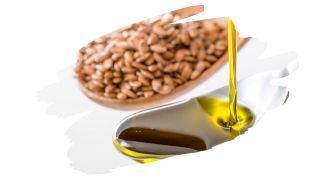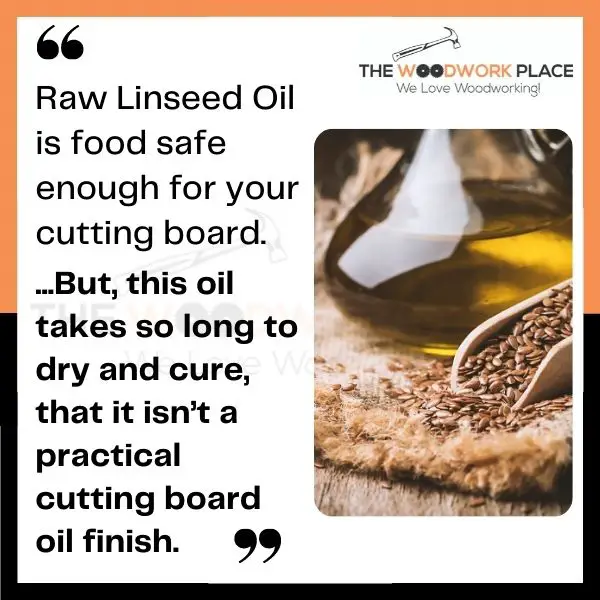A quality oil finish can protect your cutting board from water-damage and decay.
However, many types of oil finishes are also incredibly toxic to humans. Even some natural food-sourced finishes, such as Boiled Linseed Oil, may contain drying additives. And those additives are enough to turn otherwise edible oils into something much too dangerous for human consumption.
Now, when it comes to cutting boards, only food-grade oils are safe enough to apply onto this food prepping surface.
So, where does that leave Raw Linseed Oil? This all natural (and edible) product has been used as a wood oil for centuries. And yet, how does it stack up as a cutting board finish?
Well, in this post, you will learn whether or not Raw Linseed Oil is actually a good wood finish. You’ll also discover the difference between Raw and Boiled Linseed Oil (and what this means for food safety).
And we explain why Linseed oil often doesn’t make for a practical cutting board oil finish.

This post may contain affiliate links to products that we receive a commission for (at no additional cost to you). Learn more here.
What Is Linseed Oil Used For (When It Comes To Woodworking)?
Well, this food-based oil has been added to wood stains, various oil finishes, and even paint.
Naturally sourced from crushed flaxseed, Raw Linseed Oil is non-toxic in its purest form. But, where it has excelled for centuries, (as a wood finish), is in the way it protects wood from rot.
When we apply Linseed oil onto timber, it will soak into wood grain, and coat wood fibers. And, once this oil has dried and cured into a hard resin, it forms a water-repellent barrier.
This resinous barrier prevents wood fibers from absorbing moisture, (which is the cause of wood rot).
What’s more, Linseed oil leaves a bit of build up on the surface of wood too. So, it not only protects underneath the surface, it also enhances the surface appearance of wood.
Related Post: Walnut Oil Vs Linseed Oil For Wood (What You Really Need To Know)
But, Is Linseed Oil Actually A Good Wood Finish?
Linseed oil is great at enhancing the look of wood grain. And it’s a fantastic way to add a little life into time-worn pieces.
However, it is not completely waterproof, and fairly easily water-damaged too.
What’s more, Raw Linseed Oil takes a ridiculously long time to finish setting. It takes around 3 days for Raw Linseed Oil to dry to the touch. And it can take over 2 months for it to completely cure all the way through.
What Is The Difference Between Linseed Oil Drying And Curing? Drying refers to an evaporation process that changes liquid Linseed oil into a solid (yet soft) film. Curing refers to a separate chemical process that happens alongside evaporation. This chemical process changes Linseed oil into its final hard resinous form.
What About Boiled Linseed Oil? Is That A Good Finish Too?
Well, Boiled Linseed Oil is made from Raw Linseed Oil. Except, this particular oil finish has gone through a super heated process. This process also involves adding chemical dryers to this oil finish.
Wait A Second… Is Boiled Linseed Oil Toxic?
Well, all of those chemical additives are key in allowing Boiled Linseed Oil to dry and cure faster than Raw Linseed Oil.
However, those self-same chemicals make Boiled Linseed oil toxic, and wholly unfit for human consumption.
Related Post: Boiled Linseed Oil vs Thompson’s Water Seal: Which One Is Better For Wood?
So, Is Boiled Linseed Oil Food Safe?
Boiled linseed oil is not at all food safe in its liquid, (or otherwise still curing), form. And even after it has dried, you still would not want to consume any of that Boiled Linseed Oil resin.
However, once Boiled Linseed Oil has completely cured, it is safe enough to eat off.
Still, you don’t want to risk consuming small chips of Boiled Linseed Oil resin. So, that makes this oil unsuitable for something like a butcher block or cutting board.
Also, Boiled Linseed oil isn’t the best finish for taking on a regular drenching of water, such as washing it repeatedly in the kitchen sink.
You see, Boiled Linseed oil can help repel some water at first, but it doesn’t prevent moisture from seeping in like a urethane finish can. In fact, if you were to use Boiled Linseed oil for outdoor wood projects, it probably won’t last more than a year before needing a recoat.
And that’s only one of the reasons why you’d steer clear of using this finish on outdoor structures, such as a raised garden bed. The bigger concern surrounds the chemicals used to process boiled linseed oil. You wouldn’t want those leaching into the soil where you grow food.
We’ve actually written a post exploring alternatives if you’re interested in learning more about options that are non-toxic for gardens: Is Boiled Linseed Oil A Safe Wood Finish For Garden Beds?

What About Linseed Oil? Is Raw Linseed Oil Food Safe For Cutting Boards Or Butcher Blocks?
Raw Linseed Oil, (that has been certified as ‘Food-Grade’), is food safe enough to be applied onto a cutting board.
However, this wood finish is easily water-damaged if it gets drenched. And any cutting board or butcher block will be washed and rinsed regularly.
So, any Raw Linseed Oil finish you do apply on a cutting board, won’t stay on it for very long. You would need to reapply Raw Linseed Oil, to a cutting board, very frequently.
Also, when you leave Raw Linseed oil in a constantly moist environment, mold can begin to develop and grow on this oil finish. This is one of the reasons why slow-drying Raw Linseed oil isn’t recommended for outdoor applications.
So, a regularly rinsed cutting board provides the perfect environment for bacteria to grow on a Raw Linseed Oil finish.
Plus, another disadvantage to using Linseed oil, is its incredibly long drying/curing time. Waiting weeks for this oil to cure, (before you can use your cutting board again), isn’t practical.
Related Post: How To Make Linseed Oil Dry Faster (What You Need To Know)
And on top of all of that, Linseed oil is a microporous finish. And microporous finishes aren’t the most durable against heat and moisture over time, which a cutting board sees a lot of.
Microporous basically means the finish can repel liquid water droplets sitting on the surface, but it can’t prevent water vapor from seeping through. So something like a steaming hot mug or pan can still damage the finish. The wood itself can even start to crack if it’s not a stable wood, since the moisture gets down into the grain. You can learn more about that here: Will Linseed Oil Alone Be Enough To Stop Wood From Cracking?
So What Other Wood Oil Is Food Safe Enough For A Cutting Board?
A 100% pure food-grade mineral oil is a much more suitable cutting board wood finish. Unlike Linseed oil, this oil is non-drying, so there’s no waiting around for it to cure.
On top of that, mineral oil is made from petroleum distillate. This is a highly refined and filtered version of petroleum. So much so, it is safe for human consumption. It does not expire, and it does not go rancid. So, you’ll experience no risk of mold growth.
Mineral oil works just like Linseed oil too. Which means that this affordable oil finish will soak right into wood grain, and coat wood fibers.
However, Mineral oil leaves next to no build up on the surface. And, more importantly, this oil does not dry, does not cure, and it does not harden into a resin.
This is why mineral oil is the gold standard for sealing and protecting food prepping surfaces. And you can buy pure food grade mineral oil from most any local pharmacy.
To Wrap Up, Here Are The 3 Key Takeaways From This Post…
- 1). Raw Linseed Oil is a pure natural oil that is extracted from flaxseed. It is non-toxic and safe for human consumption.
- 2). However, Boiled Linseed Oil is a Raw Linseed Oil derivative. It contains toxic chemical dryers and other additives. It is not safe for human consumption.
- 3). Raw Linseed Oil is food safe enough for your cutting board. But, this oil takes so long to dry and cure, that it isn’t a practical cutting board oil finish.
References:
Nykter, Minna, Hanna-Riitta Kymäläinen, and Fred Gates. “Quality characteristics of edible linseed oil.” Agricultural and food science 15.4 (2006): 402-413.



